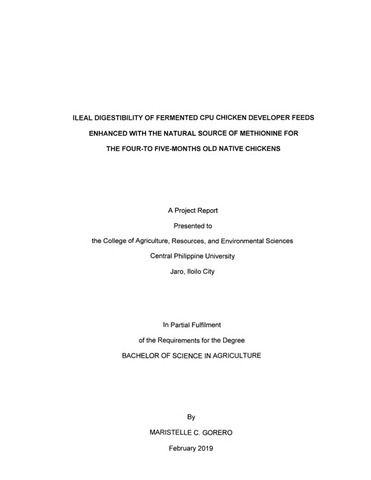Production potentials of native chickens (Gallus gallus domesticus L.) of Western Visayas, Philippines
| dc.contributor.author | Cabarles, Jaime C. Jr. | |
| dc.date.accessioned | 2021-05-19T00:47:52Z | |
| dc.date.available | 2021-05-19T00:47:52Z | |
| dc.date.issued | 2013-02 | |
| dc.identifier.citation | Cabarles, J. C., Jr. (2013). Production potentials of native chickens (Gallus gallus domesticus L.) of Western Visayas, Philippines. Tropical Animal Health and Production, 45(2), 405–410. | en_US |
| dc.identifier.issn | 0049-4747 | |
| dc.identifier.uri | https://hdl.handle.net/20.500.12852/883 | |
| dc.description.abstract | Poultry genetic resources diversity serves as a reservoir of genes adaptable to local conditions, production, resource utilization, and production that are compatible with consumer preferences for meat and egg products. This study was, therefore, conducted to determine the production potentials of native chickens in Western Visayas, Philippines. A total of 270 raisers were interviewed and 810 chickens were characterized. These numbers were divided equally among the provinces of Aklan, Antique, Capiz, Guimaras, Iloilo, and Negros Occidental. The data collected were analyzed using one-way analysis of variance and significant differences were determined using the Duncan’s Multiple Range Test. Results show that native chickens from Aklan had the highest (P < 0.01) hatching percentage (93.10 ± 1.67 %) and oldest (P < 0.01) slaughter/marketing age (23.56 ± 1.03 weeks). Those from Guimaras had the biggest (P < 0.01) egg (42.69 ± 0.87 g) and heaviest slaughter/marketing weight (920.00 ± 22.72 to 924.44 ± 23.01 g); the shortest (P < 0.01) clutch interval (77.87 ± 4.14 days) was observed from those in Iloilo. Those from Antique had the highest (P < 0.01) survival rate from 1 day old to a slaughter/marketing age of 52.48 ± 1.83 %. The adult live weight ranged from 1.27 ± 0.04 to 1.62 ± 0.04 kg with those from Aklan as the lowest (P < 0.01) while those from Guimaras were the highest. Thus, the observed variations in reproductive and growth performances of native chickens from this region expressed their potentials for genetic improvement toward production. | en_US |
| dc.description.sponsorship | The author expresses his deepest gratitude to the Department of Science and Technology–Philippine Council for Agriculture, Forestry and Natural Resources Research and Development (DOST-PCARRD), Central Philippine University (CPU), and Commission on Higher Education (CHED) for the financial support in conducting this study. The assistance from the Magsasaka at Siyentipiko para sa Pag-unlad ng Agrikultura (MASIPAG) and those from the local government officials of the different sampling sites in Western Visayas, Philippines during the field visit and data collection are likewise acknowledged. | en_US |
| dc.language.iso | en | en_US |
| dc.publisher | Springer | en_US |
| dc.subject.lcsh | Genes | en_US |
| dc.subject.lcsh | Chickens | en_US |
| dc.subject.lcsh | Poultry | en_US |
| dc.subject.lcsh | Poultry industry | en_US |
| dc.subject.lcsh | Philippines--Western Visayas | en_US |
| dc.title | Production potentials of native chickens (Gallus gallus domesticus L.) of Western Visayas, Philippines | en_US |
| dc.type | Article | en_US |
| dc.citation.firstpage | 405 | en_US |
| dc.citation.lastpage | 410 | en_US |
| dc.citation.journaltitle | Tropical Animal Health and Production | en_US |
| dc.citation.volume | 45 | en_US |
| dc.citation.issue | 2 | en_US |
| local.subject | Native chickens | en_US |
| local.subject | Genetic diversity | en_US |
| local.subject | Reproductive performances | en_US |
| local.subject | Growth performances | en_US |
| local.subject | Production potentials | en_US |
| local.subject | Gallus gallus domesticus L. | en_US |
| local.subject.scientificname | Gallus gallus | en_US |
| dc.identifier.doi | 10.1007/s11250-012-0230-1 | |
| dc.identifier.essn | 1573-7438 | |
| local.relation.associatedcontent | https://link.springer.com/article/10.1007/s11250-012-0230-1 Journal website (version of record) | en_US |
Files in this item
| Files | Size | Format | View |
|---|---|---|---|
|
There are no files associated with this item. |
|||
This item appears in the following Collection(s)
-
Journal articles [25]




